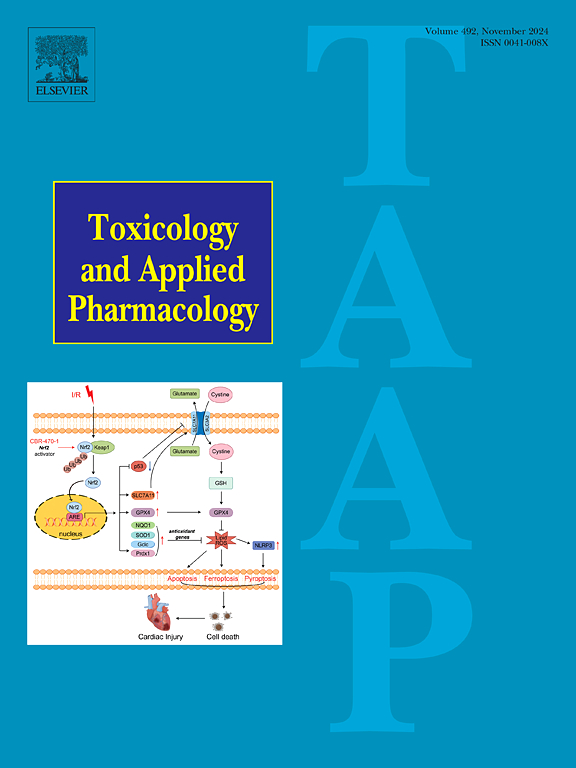Rat-to-human PBPK model of U-47700: Unveiling pharmacokinetic risks of a synthetic opioid through interspecies extrapolation
IF 3.4
3区 医学
Q2 PHARMACOLOGY & PHARMACY
引用次数: 0
Abstract
U-47700, a synthetic μ-opioid receptor agonist and emerging new psychoactive substance, poses critical public health risks due to its high abuse liability and fatal overdose potential. Ethical barriers prohibit clinical pharmacokinetic studies of such controlled substances, necessitating alternative approaches. Here, we developed the first physiologically based pharmacokinetic (PBPK) model for U-47700 by integrating in vitro experiments—including Caco-2 permeability, tissue-plasma partitioning, plasma protein binding, and human liver microsomal clearance. The rat PBPK model accurately predicted plasma concentration-time profiles across doses, and the metabolite's PBPK model was further established and validated to describe the kinetics of N-desmethyl-U-47700 and N,N-didesmethyl-U-47700. Human extrapolation via IVIVE (in vitro-in vivo extrapolation) and allometric scaling revealed rapid systemic clearance (0.944–1.371 L/h/kg). For illicit drugs like U-47700, where clinical trials are unfeasible, this PBPK framework bridges computational modeling, preclinical insights, and real-world evidence, offering a critical tool to decode pharmacokinetic curves, estimate administration timelines from postmortem samples, and assess polydrug interaction risks. By enabling mechanistic insights into synthetic opioid toxicity, this work informs overdose prevention strategies and mitigates the societal impact of high-risk designer drugs.

U-47700大鼠对人PBPK模型:通过种间外推揭示合成阿片类药物的药代动力学风险
U-47700是一种合成μ-阿片受体激动剂和新兴的新型精神活性物质,由于其高滥用风险和致命的过量潜力,构成了严重的公共卫生风险。伦理障碍禁止对此类受控物质进行临床药代动力学研究,因此需要其他方法。在这里,我们通过整合体外实验,包括Caco-2通透性、组织-血浆分配、血浆蛋白结合和人肝微粒体清除,建立了U-47700的第一个基于生理的药代动力学(PBPK)模型。大鼠PBPK模型准确预测了不同剂量的血浆浓度-时间曲线,并进一步建立和验证了代谢物的PBPK模型,以描述N,N-去甲基- u -47700和N,N-二去甲基- u -47700的动力学。通过IVIVE(体外-体内外推法)和异速测量法进行的人体外推显示,系统清除率快速(0.944-1.371 L/h/kg)。对于像U-47700这样无法进行临床试验的非法药物,该PBPK框架将计算模型、临床前见解和真实世界证据联系起来,为解码药代动力学曲线、估计死后样本的给药时间表和评估多药相互作用风险提供了关键工具。通过对合成阿片类药物毒性的机制洞察,这项工作为过量预防策略提供了信息,并减轻了高风险设计药物的社会影响。
本文章由计算机程序翻译,如有差异,请以英文原文为准。
求助全文
约1分钟内获得全文
求助全文
来源期刊
CiteScore
6.80
自引率
2.60%
发文量
309
审稿时长
32 days
期刊介绍:
Toxicology and Applied Pharmacology publishes original scientific research of relevance to animals or humans pertaining to the action of chemicals, drugs, or chemically-defined natural products.
Regular articles address mechanistic approaches to physiological, pharmacologic, biochemical, cellular, or molecular understanding of toxicologic/pathologic lesions and to methods used to describe these responses. Safety Science articles address outstanding state-of-the-art preclinical and human translational characterization of drug and chemical safety employing cutting-edge science. Highly significant Regulatory Safety Science articles will also be considered in this category. Papers concerned with alternatives to the use of experimental animals are encouraged.
Short articles report on high impact studies of broad interest to readers of TAAP that would benefit from rapid publication. These articles should contain no more than a combined total of four figures and tables. Authors should include in their cover letter the justification for consideration of their manuscript as a short article.

 求助内容:
求助内容: 应助结果提醒方式:
应助结果提醒方式:


